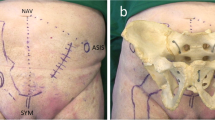Abstract
Purpose
We present our experience of using a newly modified Stoppa approach combined with a lateral approach to the iliac crest in patients with acetabular fractures in reference to fracture reduction and fixation, technical aspects, and the incidence of complications.
Methods
We used a consecutive group of 29 adult patients with acetabular fractures treated operatively with a newly modified Stoppa approach between 2009 and 2011. The newly modified Stoppa approach was performed to fix the acetabular fractures with main anterior displacement and the anterior and lateral parts of the pelvis. This approach was combined with a lateral approach on the iliac crest for fractures of the iliac wing.
Results
All the patients were followed up for at least 1.5 years. Of the 29 patients, ten anterior column, two associated both column, seven anterior column with posterior hemi-transverse, four transverse, and six T-type fractures. The average blood loss was 950 mL, and average operative time was 155 minutes. Anatomic or satisfactory reduction was achieved in 96 % of the acetabular fractures. Two patients had mild symptoms of the lateral femoral cutaneous nerve and improved within three months.
Conclusions
The newly modified Stoppa approach provides excellent visualization to the anterior column, quadrilateral surface and permits good postoperative results for treatment of acetabular fractures. We considered this technique as a viable alternative for the ilioinguinal approach when exposure of the anterior acetabulum is needed.




Similar content being viewed by others
References
Letournel E (1993) The treatment of acetabular fractures through the ilioinguinal approach. Clin Orthop Relat Res 292:62–76
Judet R, Judet J, Letournel E (1964) Fractures of the acetabulum: classification and surgical approaches for open reduction. Preliminary report. J Bone Joint Surg Am 46:1615–1646
Letournel E (1994) Fractures of the acetabulum. A study of a series of 75 cases. 1961. Clin Orthop Relat Res 305:5–9
Letournel E (1980) Acetabulum fractures: classification and management. Clin Orthop Relat Res 151:81–106
Letournel E (2006) Fractures of the acetabulum: a study of a series of 75 cases – Les fractures du cotyle, etude d'une serie de 75 cas. J de Chirurgie 82:47–87, 1961. (Translated and substantially abridged). J Orthop Trauma 20(1 Suppl):S15–19
Cole JD, Bolhofner BR (1994) Acetabular fracture fixation via a modified Stoppa limited intrapelvic approach. Description of operative technique and preliminary treatment results. Clin Orthop Relat Res 305:112–123
Gupta RK, Singh H, Dev B, Kansay R, Gupta P, Garg S (2009) Results of operative treatment of acetabular fractures from the Third World—how local factors affect the outcome. Int Orthop 33(2):347–352
Hirvensalo E, Lindahl J, Kiljunen V (2007) Modified and new approaches for pelvic and acetabular surgery. Injury 38(4):431–441
Ponsen KJ, Joosse P, Schigt A, Goslings JC, Luitse JS (2006) Internal fracture fixation using the Stoppa approach in pelvic ring and acetabular fractures: technical aspects and operative results. J Trauma 61(3):662–667
Jakob M, Droeser R, Zobrist R, Messmer P, Regazzoni P (2006) A less invasive anterior intrapelvic approach for the treatment of acetabular fractures and pelvic ring injuries. J Trauma 60(6):1364–1370
Qureshi AA, Archdeacon MT, Jenkins MA, Infante A, DiPasquale T, Bolhofner BR (2004) Infrapectineal plating for acetabular fractures: a technical adjunct to internal fixation. J Orthop Trauma 18(3):175–178
Matta JM (2006) Operative treatment of acetabular fractures through the ilioinguinal approach: a 10-year perspective. J Orthop Trauma 20(1 Suppl):S20–29
Helfet DL, Borrelli J Jr, DiPasquale T, Sanders R (1992) Stabilization of acetabular fractures in elderly patients. J Bone Joint Surg Am 74(5):753–765
Stoppa RE (1989) The treatment of complicated groin and incisional hernias. World J Surg 13(5):545–554
Matta JM (1996) Fractures of the acetabulum: accuracy of reduction and clinical results in patients managed operatively within three weeks after the injury. J Bone Joint Surg Am 78(11):1632–1645
Pohlemann T, Gansslen A, Schellwald O, Culemann U, Tscherne H (1996) Outcome after pelvic ring injuries. Injury 27(Suppl 2):B31–38
Harris WH (1969) Traumatic arthritis of the hip after dislocation and acetabular fractures: treatment by mold arthroplasty. An end-result study using a new method of result evaluation. J Bone Joint Surg Am 51(4):737–755
Ghalambor N, Matta JM, Bernstein L (1994) Heterotopic ossification following operative treatment of acetabular fracture. An analysis of risk factors. Clin Orthop Relat Res 305:96–105
Moed BR, Dickson KF, Kregor PJ, Reilly MC, Vrahas MS (2010) The surgical treatment of acetabular fractures. Instr Course Lect 59:481–501
Sagi HC, Afsari A, Dziadosz D (2010) The anterior intra-pelvic (modified Rives-Stoppa) approach for fixation of acetabular fractures. J Orthop Trauma 24(5):263–270
Andersen RC, O’Toole RV, Nascone JW, Sciadini MF, Frisch HM, Turen CW (2010) Modified stoppa approach for acetabular fractures with anterior and posterior column displacement: quantification of radiographic reduction and analysis of interobserver variability. J Orthop Trauma 24(5):271–278
Ebraheim NA, Patil V, Liu J, Sanford CG Jr, Haman SP (2007) Reconstruction of comminuted posterior wall fractures using the buttress technique: a review of 32 fractures. Int Orthop 31(5):671–675
Sen RK, Tripathy SK, Aggarwal S, Tamuk T (2011) Posterior wall reconstruction using iliac crest strut graft in severely comminuted posterior acetabular wall fracture. Int Orthop 35(8):1223–1228
Stockle U, Hoffmann R, Nittinger M, Sudkamp NP, Haas NP (2000) Screw fixation of acetabular fractures. Int Orthop 24(3):143–147
Pungpapong SU, Thum-umnauysuk S (2005) Incidence of corona mortis; preperitoneal anatomy for laparoscopic hernia repair. J Med Assoc Thai 88(Suppl 4):S51–53
Conflict of interest
None.
Author information
Authors and Affiliations
Corresponding author
Rights and permissions
About this article
Cite this article
Liu, Y., Yang, H., Li, X. et al. Newly modified Stoppa approach for acetabular fractures. International Orthopaedics (SICOT) 37, 1347–1353 (2013). https://doi.org/10.1007/s00264-013-1920-7
Received:
Accepted:
Published:
Issue Date:
DOI: https://doi.org/10.1007/s00264-013-1920-7




